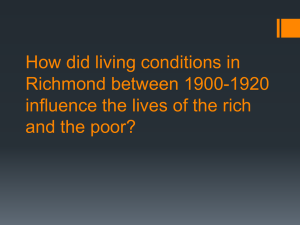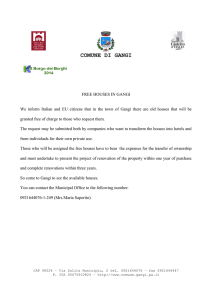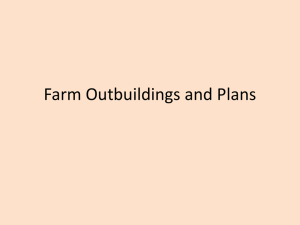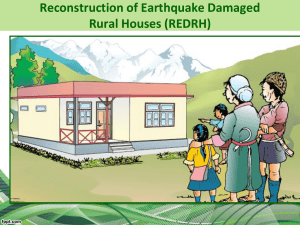Living Conditions in Richmond in the 1900*s
advertisement
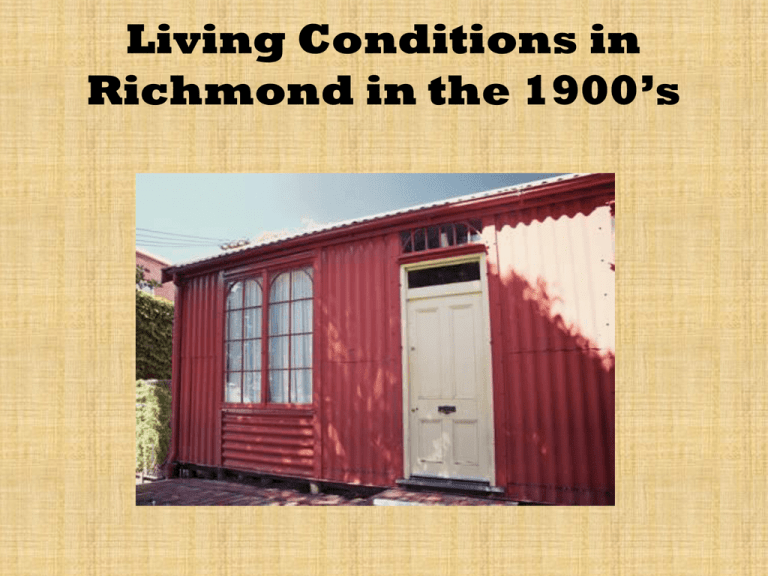
Living Conditions in Richmond in the 1900’s What was used in early colonisation? • In early colonisation, tents were used by settlers as houses. They had no clue about houses and therefore led to them only having tents to use. • Tents were not sufficient as they didn’t provide large areas to sleep and live in. They also didn’t protect people from severe weather conditions as tents were only made of thin materials. • Food had to be captured in the form of animals and early settlers had to learn from Aboriginal people on how to do such things. • At this stage in time, medical technology was very low and diseases were hardly treated with the right medication. Progression to Iron Houses • As people had learned more about the way architecture worked they decided that iron houses would be a more efficient way of living. • Progression of living in houses started when iron houses hit Australia in the early 1900’s. Iron houses were a big step forward because compared to tents, they provided more protection from weather including rain and sun because of the way they were designed. These iron houses were also larger than tents and provided more space for leisure. • As iron houses became more popular, they would become cheaper and were a more popular way of living. • People living in these iron houses would normally rent, an average weekly rent for a three bedroom apartment was $1.30 which is about $65.00 nowadays. Brick Houses Finally Arrive • By the 1950’s people had started to research a better way of living. They stumbled upon the idea of building brick houses. They realised that brick house would give people better protection from extreme weather and intruders. • Brick houses were also considered bigger and stronger and many families would share these houses and live together. • Brick houses became the choice of house in a short few years and people had managed to start building these houses by themselves to allow them to save money. Pollution - Gasworks • Gasworks was (as the name says) is the place where gas was produced and supplied to various houses and factories. • Although the people working for Gasworks had earned enough money for themselves, they were affecting the people living around the Gasworks area. People remember walking in the area around Gasworks like it was “walking through a continuous cloud of smoke”. It had also affected people because the smell of the gas was affecting peoples health. • The gas was also producing black droplets which would fill the ground and children weren’t able to play outside because it was very hard to see. • The pollution to the air had already affected many people by the time the factory closed down in 1957. Medicine • In the early 1900’s medical technology was not as advanced as it is today. Surgery had hardly been introduced and medical cures to diseases were nearly impossible to come by. • Many people were scared to have babies as infant mortality rates were as high as 70-80% of babies dying before they reached the age of 1. • The cure for many diseases such as the common cold, typhoid and even the flu had not yet been found which was a major contributing factor for early deaths. • Streets in Richmond were very crowded and dirty because there sewerage or rubbish collection systems which allowed diseases a more stable environment to spread from person to person. • Medicine had not become very advanced until the 1960’s when surgery had become more popular and diseases were more curable. The Role of Entertainment • Entertainment came in the form of sport and drama, sport played at the MCG and other local grounds and drama being performed at various theatres. • People would watch these different forms of entertainment to allow them and their families some rare times of enjoyment. • Entertainment was also helpful to people as it allowed them to take their minds off the war that was going on at the time. • Tickets to watch the football were 10 cents and to watch a play or concert at a theatre it was 70 cents. Bibliography • http://www.gasworks.org.au/about-us/history • http://www.slideshare.net/hsiesje/australia-health-in-the-early-1900s • http://www.abs.gov.au/ausstats/abs@.nsf/Previousproducts/1301.0Featu re%20Article482001?opendocument&tabname=Summary&prodno=1301. 0&issue=2001&num=&view Adriano Stenta


